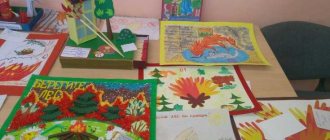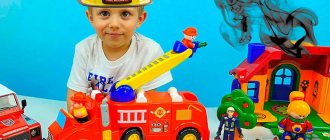Fire safety quest game “You may not be a firefighter, but you must know the rules”
Quest game for fire safety stations “You may not be a firefighter, but you must know the rules”
Target:
consolidating students' knowledge about fire safety through games.
Objectives:
1. consolidate knowledge about fire safety rules;
2.develop a sense of collectivism and mutual assistance; 3.organization of leisure activities for children. Preparatory work:
students are divided into the number of teams according to the number of stations (I have 10);
teams are formed as follows: in each team there are students from grades 1 to 11 (1, 2 students). The game was played outside. Preliminary work:
route sheets are prepared, a trained adult stands at each station.
Necessary equipment:
a barrel with markings, buckets, a fire safety poster, clothing (jacket, helmet, mittens, etc. at the conductor’s choice), an envelope with a cut picture;
medical equipment (if possible). Progress of the event: 1. Team building.
2.Introductory remarks. We say – fire is our friend!
But he will suddenly become an enemy, If we forget about him, He will immediately take revenge on people. You will regret it in the battle with fire. Here he is scary and harsh - And there is a lot of firewood from the house. - Guys, all of you have probably seen more than once how red cars rush through the city, blocking the smooth noise of the streets with alarm signals. This means that there is a fire somewhere and someone needs immediate help. And how often on TV they show fires occurring in different parts of the country. Usually you listen to all this and think that this does not apply to you personally. And yet, the number of fires is increasing. Now we will check and consolidate our knowledge about fire safety. Please choose captains! 3Explanation of the rules of the game.
-You must be friendly, fast, dexterous and smart to win!
But that doesn't mean you should rush! Good luck everyone! The guys start moving in accordance with the route sheets. 1st station “How to put out a fire.”
Students are asked to list all the fire extinguishing means they know (water, foam, snow, earth, sand, carbon dioxide, fire extinguishers, etc.).
For each answer 1 point. Then the team is offered an envelope containing a cut-out illustration of an item related to fire safety. Teams must create this image and name it. Then each team member must tell them how to use it. The correctness and accuracy of execution is assessed. (For example, a fire extinguisher.) Station 2 “How to provide first aid to a person who has received a thermal burn.”
The guys answer the question, applying the acquired knowledge in the lessons.
They start with the younger kids. You can offer to choose the necessary medications and instruments needed in this case (syringe, scissors, bandage, cotton wool, nasal drops, mustard plasters, brilliant green, cream (whatever is available). In theory, the guys should choose practically nothing. Then the adult at the station summarizes the children's answers: There are four degrees of burn: 1 - redness of the skin, swelling; 2 - the appearance of blisters; 3 - a scab forms at the burn site; 4 - charring of the tissue. First aid is provided only for the first degree of burn. It is necessary immediately treat with a clean soft cloth moistened with alcohol to disinfect and reduce pain. Subsequently, a bandage with furatsilin can be applied to the affected area. Burns of other degrees are not treated, they are protected with a dry sterile bandage. Do not use fat or petroleum jelly for burns, as well as solutions of potassium permanganate and "green marks", which make it difficult to recognize the severity of the burn. Work at the station is assessed on a 5-point system. 3 station "Water carriers".
- Guys, remember what the sign that indicates a fire-fighting reservoir looks like?
— Where on the territory of our camp are these signs located? -What is most often used to put out fires? (Water). — How should firefighters work? (Clearly, harmoniously). - Now you will fill the barrel with water, to do this you must line up in a chain and pass the bucket to each other! You are given 3 minutes to complete the work. Think about how it is more convenient for you to stand up, who will do what. (On the barrel there is a marking of the volume of water, the number and size of buckets at the choice of the person conducting the event). The sheets indicate the amount of water collected and how accurately the guys worked. Station 4 “It’s not a riddle without a answer”
The presenter reads riddles to each team.
For the correct answer 1 point. The red cow ate all the straw. (Fire.) In a small barn there is a fire on fire. (Matchbox and matches.) Bury it - it won’t rot, throw it in water - it will float. (Coal.) The red bull stands, trembles, the black one runs to the sky. (Fire and smoke.) Small, remote, but brings big trouble. (Spark.) I come from fire, and from fire I die. (Coal.) There is a house with fifty sisters in it. I would advise the children, don’t play with the house with this! (Matchbox.) No matter how much you eat, you will never be full. (Fire.) Station 5 “Motto of the fire department.”
Each team is given a separate sheet with incomplete mottos.
The children are asked to add lines to the motto. Evaluated when summing up results. • ……………………………………………………….. That you can’t joke with fire! • Easier than putting out a fire, ……………………………………………………. 6th station “Question - answer”
The presenter asks questions, for the correct answer - a card, points are assigned according to the number of cards earned.
Questions: 1. Which organ is protected by a cotton-gauze bandage during a fire? (Breathing.) 2. Burn caused by flame, boiling water, steam, or touching hot metal objects. (Thermal) 3. Fire extinguishing agent. (Fire extinguisher.) 4. What exit should be sought during evacuation in case of fire in a store, cinema and other public places? (Emergency.) 5. Fire department number? (01.) Children must also remember the number to call the car from a cell phone! 6. Why is the fire department telephone number 01? • 01 – simple, everyone will remember it, • 01 – short number, every minute counts in a fire, • 01 – convenient number, easy to dial in the dark on the telephone dial. 4. What should you do if smoke comes out of a working TV or some other electrical appliance? Answer: I'll unplug it and throw a damp blanket over the TV. 5. What should not be done to extinguish live electrical wiring? Why? Answer: You cannot extinguish with water and foam fire extinguishers, since water is a conductor of electric current. 6. What to do if gasoline spilled near the garage caught fire? Answer: I will put out the fire with sand or earth. Station 7 “The most attentive”
A) The guys are asked questions for their attention: -Where are the fire extinguishers in our building?
— Where is the fire control panel located in the building of the country base? — Where is the evacuation plan? Etc. B) Select captions for the posters. The children are offered a poster with fire safety rules. It is suggested to select captions under the pictures. (The poster is familiar to the guys; it hangs at the entrance to the camp building). Correctness of answers is assessed - 1 point. Station 8 “Dress the fireman.”
Two chairs (benches, stumps on the court), the team stands at one chair, the captain at the other.
On the chair there is a jacket, mittens, a helmet, a hose (skipping rope, gymnastic stick). Each child runs up to the captain, the captain dresses the child, he takes the hose, runs around the chair, and undresses. Passes the baton to a friend. This is how all children pass the relay race. The passage time and calmness in actions are taken into account. After passing, the presenter makes a conclusion with the guys that everything needs to be done clearly, consistently, without fuss. 9 station “Select action”.
What should you do if a person finds himself in a fire zone and his clothes catch fire?
Your actions are in order. Explain what they are based on. The children are given time to think and prepare an answer. Answer: You can’t run around in burning clothes; this only makes the flames worse. If a small area is on fire, remove clothing and extinguish it away from flammable objects. When the flame covers most of the clothing, first of all, you need to take a horizontal position so that the fire does not spread to the head, and then extinguish it with water, snow, sand, liquid mud, fire extinguishing powder, you can even use a foam fire extinguisher. The victim must close his eyes. Station 10 "Black Box".
The presenter shows a black box containing an item related to fire safety.
Each team takes turns asking questions about the contents of the box. The presenter can only answer “yes”, “no”, “hot”, “cold”. Evaluated on a 5-point system, guesses the item in a shorter time. (Iron.) After counting the points and discussing the progress of the game, the results are summed up.
Prizes and diplomas for winners and participants. Host: Guys, always remember that it is easier to prevent a fire than to put it out, that a small match can turn into a big disaster. To avoid a fire, you must know and strictly follow fire safety rules. But if a fire does occur, you need to clearly know how to behave. Try to let fire always be your friend and never become your enemy. Protect your life, the lives of other people, the house you live in, and the school you study at from fire!


